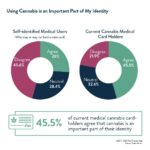More Americans Are Seeing Green

Medical cannabis use and identity: The role of state laws
March 7, 2023
U.S. Cannabis Sales Could Total $71B in 2030 Without Federal Legalization
March 22, 2023By Noah Tomares, Senior Research Analyst, New Frontier Data
According to a Pew Research Survey conducted in October last year, nearly nine in ten adults (88%) say cannabis should be legal. Six in ten (59%) supported both medical and adult-use, while an additional three in ten (30%) supported medical use only. Just 10% of those surveyed thought cannabis should not be legal.
Support for legal cannabis does not necessarily reflect a more permissive view on drug usage generally. Recently, the CDC released a research brief indicating that a majority of American adults (57%) would support “a policy prohibiting the sale of all tobacco products.”
It seems more likely that increasing openness and receptivity to legal cannabis is inexorably intertwined with the continued expansion of access to legal cannabis. Before the first legal adult-use markets came online, Gallup reported that 50% of Americans favored legalizing cannabis. In the decade since, Gallup has reported steady growth in support for legal cannabis.
Maryland, Missouri, and Rhode Island passed measures to legalize adult-use cannabis sales in 2022. That makes a total of 22 states (including D.C.) that have legalized access to high-THC cannabis for adult-use, and 39 (including D.C.) where high-THC cannabis is legal for medical use.
These evolving legal frameworks have amounted to approximately 159 million Americans—nearly half of American adults (47%)—living in states that have access to legal adult-use cannabis. Nearly three in four (73%) have access to legal medical cannabis in some form. That’s 246 million people living in states with some form of legalized access to high-THC cannabis. Conversely, 90 million Americans (27%) reside in states where possession and use of cannabis remains illegal.
In New Frontier Data’s latest report, 2023 U.S. Cannabis Report: Market Updates & Projections, we identify 18 potential states that are demonstrating a strong likelihood to legalize either adult-use or medical cannabis prior to 2030. If all 18 potential states are successful in enacting policy reform measures over the next eight years, the proportion of the population living in states that have legalized adult-use would grow from 47% to 66%. The percentage of Americans living in states with some form of legal cannabis access would swell to 94%. Or, put another way, just one in sixteen (6%) Americans would reside in states prohibiting possession and use of cannabis.
While more states establishing their own legal markets is not necessarily indicative of a comparable shift in federal policy, it seems clear that expansion of the legal market will continue to create further public support and social normalization that adds pressure on lawmakers. However, it remains difficult to pinpoint when federal legalization may occur, or what form it might take.
For more information on cannabis sales and growth projections, national medical cannabis program participation, and how this expansion of legal access might impact the illicit market, be sure to download a copy of the 2023 U.S. Cannabis report!




